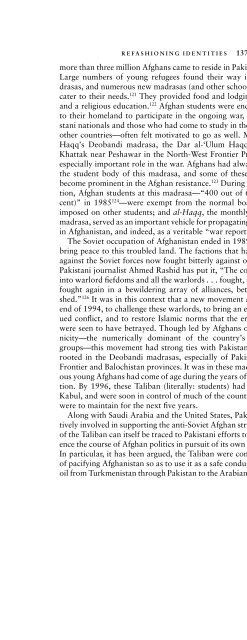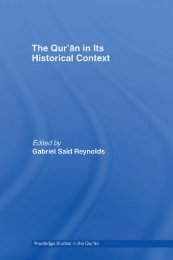Download (1 MB) - Islam and Christian-Muslim Relations: Articles ...
Download (1 MB) - Islam and Christian-Muslim Relations: Articles ...
Download (1 MB) - Islam and Christian-Muslim Relations: Articles ...
You also want an ePaper? Increase the reach of your titles
YUMPU automatically turns print PDFs into web optimized ePapers that Google loves.
REFASHIONING IDENTITIES 137more than three million Afghans came to reside in Pakistan as refugees. 120Large numbers of young refugees found their way into Pakistani madrasas,<strong>and</strong> numerous new madrasas (<strong>and</strong> other schools) were created tocater to their needs. 121 They provided food <strong>and</strong> lodging to the refugees,<strong>and</strong> a religious education. 122 Afghan students were encouraged to returnto their homel<strong>and</strong> to participate in the ongoing war, <strong>and</strong> others—Pakistaninationals <strong>and</strong> those who had come to study in these madrasas fromother countries—often felt motivated to go as well. Mawlana Sami‘ al-Haqq’s Deob<strong>and</strong>i madrasa, the Dar al-‘Ulum Haqqaniyya, in AkoraKhattak near Peshawar in the North-West Frontier Province, played anespecially important role in the war. Afghans had always formed part ofthe student body of this madrasa, <strong>and</strong> some of these students were tobecome prominent in the Afghan resistance. 123 During the Soviet occupation,Afghan students at this madrasa—“400 out of 680 (about 60 percent)” in 1985 124 —were exempt from the normal boarding restrictionsimposed on other students; <strong>and</strong> al-Haqq, the monthly magazine of thismadrasa, served as an important vehicle for propagating the cause of jihadin Afghanistan, <strong>and</strong> indeed, as a veritable “war reporting magazine.” 125The Soviet occupation of Afghanistan ended in 1989, but that did notbring peace to this troubled l<strong>and</strong>. The factions that had led the struggleagainst the Soviet forces now fought bitterly against one another. As thePakistani journalist Ahmed Rashid has put it, “The country was dividedinto warlord fiefdoms <strong>and</strong> all the warlords . . . fought, switched sides <strong>and</strong>fought again in a bewildering array of alliances, betrayals <strong>and</strong> bloodshed.”126 It was in this context that a new movement arose, towards theend of 1994, to challenge these warlords, to bring an end to their continuedconflict, <strong>and</strong> to restore <strong>Islam</strong>ic norms that the erstwhile mujahidinwere seen to have betrayed. Though led by Afghans of the Pashtun ethnicity—thenumerically dominant of the country’s numerous ethnicgroups—this movement had strong ties with Pakistan <strong>and</strong> was, in fact,rooted in the Deob<strong>and</strong>i madrasas, especially of Pakistan’s North-WestFrontier <strong>and</strong> Balochistan provinces. It was in these madrasas that numerousyoung Afghans had come of age during the years of the Soviet occupation.By 1996, these Taliban (literally: students) had taken the capital,Kabul, <strong>and</strong> were soon in control of much of the country—a control theywere to maintain for the next five years.Along with Saudi Arabia <strong>and</strong> the United States, Pakistan had been activelyinvolved in supporting the anti-Soviet Afghan struggle. And the riseof the Taliban can itself be traced to Pakistani efforts to continue to influencethe course of Afghan politics in pursuit of its own geostrategic goals.In particular, it has been argued, the Taliban were conceived as a meansof pacifying Afghanistan so as to use it as a safe conduit of Central Asianoil from Turkmenistan through Pakistan to the Arabian Sea. This abortive



